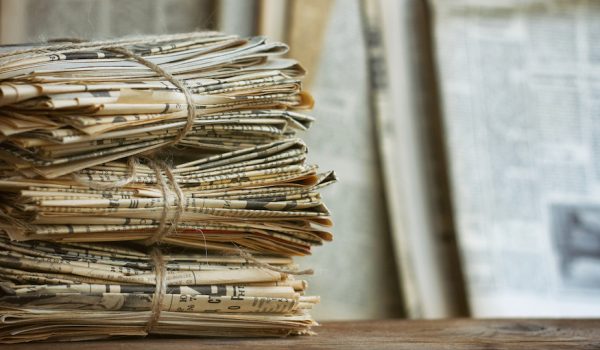

In today’s “digital age,” it may seem strange that some family historians hang on to old newspapers and clippings. There are many good reasons to keep these items- perhaps most importantly, they are original source documents for current and future genealogical research. Published news such as wedding announcements, obituaries, and important historical events about our ancestors, provide a wealth of information that may not be found in other records. To save newspaper clippings for the next generation of researchers, it is important to understand how to properly handle and store them. This article reviews some dos, don’ts, and best practices for preserving your historical newspapers and clippings.
Don’t store your newspaper clippings with other family history items. Most newspapers, past and present, are printed on thin, low-quality paper that was not intended to be preserved. Newsprint is highly acidic and contains impurities that cause the paper to become yellowed and brittle over time. These impurities can leach out of the paper and stain surrounding materials- for example, a newspaper clipping preserved in a book can stain the pages. This staining is permanent and cannot be removed. Clippings should be stored separately in acid-free, protective packaging (see below for a list of best storage options).
Don’t display the original newspaper clippings. Light exposure, including some types of indoor lighting, can accelerate the aging process, causing newsprint to darken and become even more brittle. Preserved clippings should be stored in a dark area such as an archival storage bin or file cabinet. If you would like to display clippings in a frame or shadowbox, use a high-quality photocopy or a digitized, printed copy instead.
Don’t laminate your clippings or use glue or tape to repair them. Laminating your clippings may seem like a great way to preserve them, but laminating sheets contain chemicals that will eventually destroy the newsprint entirely. And once the process is done, lamination is difficult, if not impossible, to reverse. Using adhesives such as glue or tape will only cause further damage to the clippings. Instead, gently place the pieces together so they can be scanned or photographed, allowing you to safely digitize the full clipping.
Don’t store clippings in the attic or basement. You may have discovered your family treasures in grandma’s attic or basement, but don’t return them there! Newspaper clippings should be stored in a dark, cool, and dry location. Damp conditions (like those found in a basement) can attract insects and encourage mold growth. Hot conditions (like those found in an attic) can accelerate the aging process.
Don’t try to make a “do it yourself” solution to preserve clippings. Museums and archives often use special “deacidification” solutions to neutralize acids in newsprint. These solutions are available to the public but can be expensive- and a large amount is needed to properly protect an entire newspaper collection. There are online “recipes” for homemade preservation solutions, but they are not recommended. It’s better to digitize the clippings and properly store the originals.
Do handle old newspapers and clippings with care. Newsprint becomes weaker and more brittle as it ages. Chips of paper can easily break off when handled- so clippings must be handled with extreme care. If clippings or full-page articles are folded, try to unfold them very carefully- but stop if you seem to be causing damage. Make sure hands are clean and dry when handling, as oils or lotions can stain the old newsprint. Cotton or nitrile gloves can be used if preferred.
Do digitize your newspaper collection. Even if you prefer to save the original clippings, creating a digitized backup of your collection is critical. With torn or chipped clippings, you can piece them together to get a full image, as using tape and glue is a no-no. A digitized collection can be easily shared with family, friends, and other family historians. Additionally, a digital backup provides peace of mind that your newspaper collection will live on if something should happen to the originals or if they deteriorate too far to be further preserved.
Do create a searchable index for your collection. This will help you organize your collection and assist future researchers in finding items of interest. Create a spreadsheet using search criteria such as name, locality, event, date, publication title, and page/column number. For larger collections, it may be helpful to create a numerical filing system to track individual items. The completed index can be printed and kept with the collection, and should also be saved to your computer or “cloud” storage for backup.
Do remember to save any citation and provenance information. Family historians need to know where their sources originated from. Many old clippings are missing this information. If you can locate or already have source information, but can’t add it to digitized photos or scans, be sure to add it to your index. You can also make photocopies of individual clippings and add the source citation information to the copy. Be sure to use archival photo paper to print your copies, as this will ensure the copies do not damage any other documents.
Do use the proper archival supplies. It is critical to use acid-free materials specifically meant for archiving. This will ensure your newspaper collection is preserved for future historians. See below for a list of recommended storage and preservation materials.
Do store in a cool, dry place. If possible, ensure that the temperature and humidity remain constant in the storage area. The ideal temperature is around 65 degrees Fahrenheit, with humidity around 35 percent. Keep the collection in a storage container and out of natural and artificial light.
This is a guest post by Marc McDermott, a genealogist and blogger who has a deep passion for genealogy. He blogs about genealogy at GenealogyExplained.com, where he shares tips and tricks for researching your family history. Marc lives in New Jersey with his wife Leigh and daughter Helen.